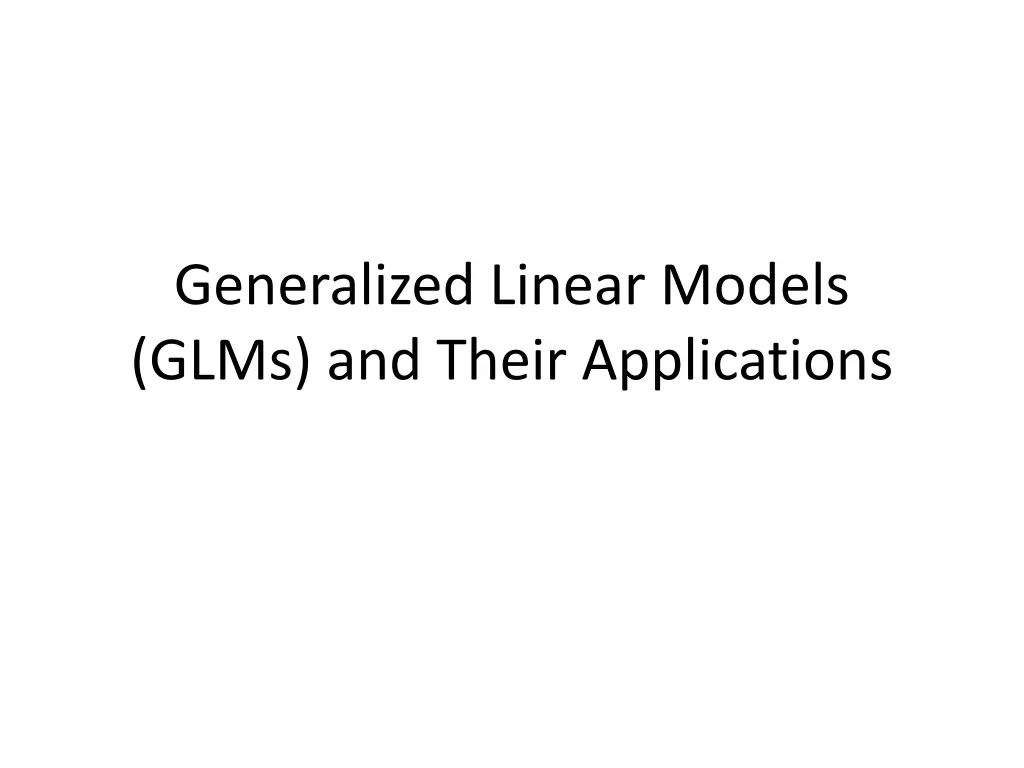
Applications of Generalized Linear Models in Regression Analysis
Explore the world of Generalized Linear Models (GLMs) and their diverse applications in regression analysis. Understand the motivation behind GLMs, the concept of random variables, independence, Simple Linear Regression (SLR), and the least squares criterion. Dive into a real-world example of SLR through Okun's Law, showcasing the relationship between unemployment rates and GDP changes.
Download Presentation

Please find below an Image/Link to download the presentation.
The content on the website is provided AS IS for your information and personal use only. It may not be sold, licensed, or shared on other websites without obtaining consent from the author. If you encounter any issues during the download, it is possible that the publisher has removed the file from their server.
You are allowed to download the files provided on this website for personal or commercial use, subject to the condition that they are used lawfully. All files are the property of their respective owners.
The content on the website is provided AS IS for your information and personal use only. It may not be sold, licensed, or shared on other websites without obtaining consent from the author.
E N D
Presentation Transcript
Generalized Linear Models (GLMs) and Their Applications
Motivation for GLMs Predict values of a single dependent or response variable (Y) using several independent or explanatory variables Treat Y as a random variable
Random Variables A random variable Z maps outcomes of an experiment to the real numbers Random Variables can be discrete or continuous and accordingly have a pmf or pdf A pmf will always sum to 1 over all real numbers and a pdf will always integrate to 1 over all real numbers Pmf s and pdf s are always nonnegative
Random Variables Suppose p is a pdf/pmf and suppose the pdf/pmf of R is p(x) and the pdf/pmf of S is p(y). Then we say that R and S have the same distribution. R and S are said to be independent if the probability of an event involving only R is unaffected by the occurrence of an event involving only S
Simple Linear Regression (SLR) Models a dependent or response variable (Y) based off of an independent or explanatory variable (X) Creates a line running through a plot of data points Y is random with a Normal distribution, X is fixed Draw a sample of size n from a population, construct model using this sample The ith observation has an X value of Xiand a Y value of Yi Independence of the Yi s
Least Squares Yi= Xi + +eiwhere eiis a normal random variable representing error; thus Yiis normally distributed by a property of normal random variables SLR model has the form i= Xi + iis the predicted or fitted value of Yi, the actual observation Least squares criterion: Choose and such that (Yi-( i))2 = (Yi- Xi- )2is minimized To find and , we differentiate (Yi- i)2with respect to and with respect to and set both equations equal to 0 The and that satisfy the least squares criterion are unique
Example of SLR-Okuns Law Every 1% rise in unemployment causes GDP to fall about 2% below potential GDP(when all resources are fully utilized) Change in GDP is Y, Change in unemployment rate is X Following graph shows change in US GDP and US unemployment rate every quarter from 1947- 2002, and fits a regression line through it Every quarter is a data point, so the sample size is 220
Example of SLR-Okuns Law We can write Okun s law as i=0.03-2Xifor the US 0.03 here means that at full employment (when X=0), GDP increases by 3% a year
Generalized Linear Models (GLM) Yi sare independent, from the same type of distribution but DON T have the same parameters Each Yiis from the exponential family of distributions is the vector of means of the Yi s and has size n x 1 There is a function g( ) where is a vector, g is invertible and g( )=X We use g to transform in such a way that we can estimate it using a linear combination of the explanatory variables
Generalized Linear Models (GLM) g is called the link function and it depends on what we assume the response distribution is If the response distribution is Normal, g is the identity function and our model will be =X This is the model for Multiple Linear Regression (MLR) X is called the design matrix and has size n x p, so the sample size is n and there are p explanatory variables is the vector of parameters and has size p x 1 can be estimated through using maximum likelihood functions
Example of GLM- Binary Variables and Logistic Regression n independent variables, Y1 Yn, each of them have a binomial distribution Binomial Distribution: Yirepresents the number of successes in niindependent trials, the probability of success in each trial is i Since iis a probability it has to be between 0 and 1 We can model iby using a function whose range is between 0 and 1
Example of GLM- Binary Variables and Logistic Regression Example: the proportion of insects killed at varying dosages of a pesticide Link function g is called logit function and is log( i/(1- i))
